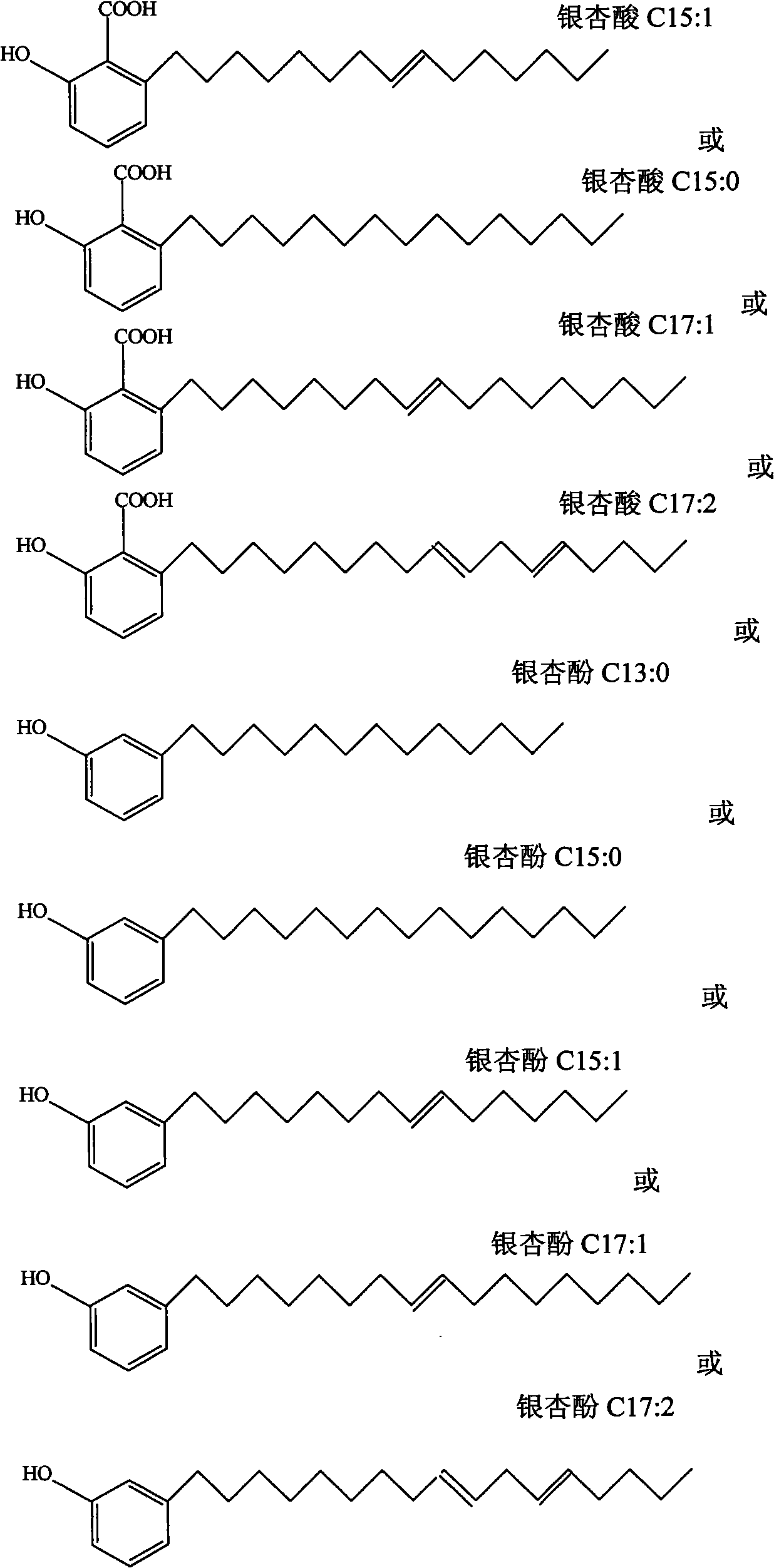Application of ginkgoic acid and ginkgol compounds to killing Ampullaria gigas
A technology of ginkgophenolic acid and compounds, applied in the field of biopesticides, can solve the problems of easy harm to the ecological environment, difficulty and cost of prevention and control, and unsuitable for large-scale use.
- Summary
- Abstract
- Description
- Claims
- Application Information
AI Technical Summary
Problems solved by technology
Method used
Image
Examples
Embodiment 1
[0020] Embodiment 1: The effect of ginkgolic acid homologues on killing apple snails
[0021] Preparation of ginkgolic acid homologues Weigh 100 g of dry ginkgo biloba testa and crush it, ultrasonically extract 5 times the amount of petroleum ether three times, each time for 2 hours, combine the extracts, filter under reduced pressure, evaporate the solvent to obtain petroleum ether extract. Dissolve the extract in a small amount of petroleum ether and apply it to a silica gel column (Φ3.2×40cm), elute with petroleum ether: ether: formic acid = 89:11:1 (v / v / v), and perform thin-layer chromatography Fluorescence at 254nm was detected, and the ginkgolic acid fraction was collected; the column was repeated several times. Finally, the ginkgolic acid components were washed with water until neutral, and the eluent was evaporated to obtain a homologous mixture of ginkgolic acids.
[0022] The HPLC analysis Varian high performance liquid chromatograph of ginkgolic acid homologue, Sin...
Embodiment 2
[0027] Example 2: The effect of ginkgolic acid C13:0 monomer on killing apple snails
[0028] Preparation of ginkgolic acid C13:0 Dissolve ginkgolic acid homologues in tetrahydrofuran: methanol = 1:1, and separate ginkgolic acid monomers with HPLC semi-preparative column HiQ C18 (250×21.2mm, 15 μm), mobile phase is methanol: 3% Acetic acid=90:10, UV detector detects the absorption peak at 280nm, collects the first peak, repeats once, and obtains ginkgolic acid C13:0 monomer. The structural formula is as follows:
[0029]
[0030] The HPLC analysis of ginkgolic acid C13:0 Varian high-performance liquid chromatograph, SinoChrom ODS-AP C18 (250 * 4.6mm, 5 μ m) analysis column, mobile phase is methanol: 3% acetic acid=92: 8 (v / v), flow rate 1.0mL / min, the ultraviolet detection wavelength is 310nm, the isolated ginkgolic acid C13:0 is analyzed, and compared with the standard, the purity of the detected ginkgolic acid C13:0 reaches 86%.
[0031] Ginkgolic acid C13:0 killing app...
Embodiment 3
[0036] Example 3: The effect of ginkgolic acid C15:1 monomer on killing apple snails
[0037] Preparation of Ginkgolic Acid C15:1 Dissolve ginkgolic acid homologues in tetrahydrofuran:methanol=1:1, separate ginkgolic acid monomer with HPLC semi-preparative column HiQ C18 (21.2×250mm, 15μm), mobile phase is methanol:3% acetic acid =90:10, flow velocity 3.0mL / min, UV detector detects absorption peak at 280nm place, collects the second peak, repeats once, obtains ginkgolic acid C15:1 monomer. The structural formula is as follows:
[0038]
[0039] The HPLC analysis of ginkgolic acid C15:1 Varian high-performance liquid chromatograph, SinoChrom ODS-AP C18 (250mm * 4.6mm, 5 μ m) analytical column, mobile phase is methanol: 3% acetic acid=92: 8 (v / v), flow velocity 1.0mL / min, the ultraviolet detection wavelength is 310nm, and the separated ginkgolic acid C15:1 is analyzed, and the purity of the detected ginkgolic acid C15:1 reaches 80%.
[0040] Ginkgolic acid C15:1 killing app...
PUM
 Login to View More
Login to View More Abstract
Description
Claims
Application Information
 Login to View More
Login to View More - R&D
- Intellectual Property
- Life Sciences
- Materials
- Tech Scout
- Unparalleled Data Quality
- Higher Quality Content
- 60% Fewer Hallucinations
Browse by: Latest US Patents, China's latest patents, Technical Efficacy Thesaurus, Application Domain, Technology Topic, Popular Technical Reports.
© 2025 PatSnap. All rights reserved.Legal|Privacy policy|Modern Slavery Act Transparency Statement|Sitemap|About US| Contact US: help@patsnap.com



